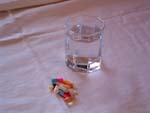A recent government report showed that record numbers of baby boomers are in treatment for drug abuse.
Baby Boomers and Drug Addiction
May 31st, 2011 · No Comments
Tags: Drug Abuse
Suicide Rates For Children Have Doubled
January 27th, 2011 · No Comments
Suicide rates have now DOUBLED for children of 5-14 years old in the past generation and has been the third leading cause of death for well over a generation.
Last year 15 million prescriptions were written for (SSRI) antidepressants for children and teenagers.
Do you think there is a correlation?
Recently the (FDA) acknowledged an increased suicide risk associated with children taking (SSRI) antidepressants.
More children and youth (ages 5-24 years) have committed suicide in the past ten years than the total number of American combat lives lost in the ten year Vietnam War (est. 55,000 v 47,355), yet little or no public attention has been given to this reality and what it represents.
The mental health of our children is worse off today than it was 50 years ago. But for years the National Institute of Health (NIH) has been following a biomedical model that seeks a drug to solve every problem. It’s clearly been a massive failure.
Tags: Prescription Drugs Addiction
Integrative Medicine Treatment for Addiction
June 7th, 2009 · No Comments
 Hyla Cass, MD, is a board-certified psychiatrist and nationally recognized expert on integrative medicine. She combines the best of natural medicine with modern science in her clinical practice, helping to replace medications with individualized natural products such as vitamins, herbs, amino acids, and bio-identical hormones.
Hyla Cass, MD, is a board-certified psychiatrist and nationally recognized expert on integrative medicine. She combines the best of natural medicine with modern science in her clinical practice, helping to replace medications with individualized natural products such as vitamins, herbs, amino acids, and bio-identical hormones.
She has created innovative formulas to help balance brain chemistry – to enhance mood for those choosing a more natural modality, and for those coming off antidepressants and anti-anxiety medications, drugs of abuse, or alcohol.
Dr. Cass is the author of a number of popular books including most recently: “Natural Highs”, and “Supplement your Prescription: What Your Doctor Doesn’t Know About Nutrition”.
Tags: Drug Addiction Alternative Treatment
Prescription Drug Abuse Among Teens on the Rise
February 10th, 2008 · No Comments
 Teens abuse prescription drugs more than any other illicit drug, except marijuana; more than cocaine, heroin, and methamphetamine combined.
Teens abuse prescription drugs more than any other illicit drug, except marijuana; more than cocaine, heroin, and methamphetamine combined.
Drug treatment admissions for prescription painkillers has increased more than 300 percent over the past 10 years. Teens are abusing prescription drugs because many believe the myth that these drugs provide a “safe” high. It is most troubling that a majority of teens who abuse prescription drugs say they are easy to obtain and many times free.
When prescription painkillers are used as prescribed, they can be of benefit. But now their abuse has become a serious public health concern along with an even greater concern for prescription drugs addictions.
Prescription drugs can be found in practically every home and parents can have immediate influence on stopping their teen from prescription drug abuse. Only a third of parents have discussed the risks of prescription drugs with their teen.
Tags: Prescription Drugs Addiction
Government Drug Schedule – What is it?
May 19th, 2007 · No Comments
The Controlled Substances Act (CSA) places all substances which were in some manner regulated under existing federal law into one of five schedules. This placement is based upon the substance’s medical use, potential for abuse, and safety or dependence liability.
Drug Placement Factors
In determining into which schedule a drug or other substance should be placed, or whether a substance should be decontrolled or rescheduled, certain factors are required to be considered. Specific findings are not required for each factor. These factors are listed in Section 201 (c), [21 U.S.C. 811 (c)] of the CSA as follows:
1- The drug’s actual or relative potential for abuse.
2- Scientific evidence of the drug’s pharmacological effects. The state of knowledge with respect to the effects of a specific drug is, of course, a major consideration. For example, it is vital to know whether or not a drug has a hallucinogenic effect if it is to be controlled due to that effect. The best available knowledge of the pharmacological properties of a drug should be considered.
Tags: Prescription Drugs Addiction · Street Drugs
Pharmaceutical Company Lies About a Drug and is Finally Fined
May 14th, 2007 · No Comments
OxyContin, a trade name for the narcotic oxycodone hydrochloride, is a time-release painkiller available by prescription. It is prescribed for relief of moderate to severe pain from such things as injuries, bursitis, neuralgia, arthritis, and cancer. Designed to be swallowed whole and digested over 12 hours, the pills can produce a heroin-like high if crushed and then swallowed, snorted or injected. As a street drug, it is commonly called OC, OX, Oxy, Oxycotton, Hillbilly heroin, and kicker.
Tags: Prescription Drugs Addiction · Street Drugs
Prescription Drug Abuse
May 5th, 2007 · No Comments
According to a National Institute on Drug Abuse research report, there are three classes of prescription drugs that are most commonly abused:
1- opioids, which are most often prescribed to treat pain – examples include: codeine, oxycodone (OxyContin and Percocet), and morphine (Kadian and Avinza);
2- central nervous system (CNS) depressants, which are used to treat anxiety and sleep disorders – examples include: barbiturates (Mebaral and Nembutal) and benzodiazepines (Valium and Xanax);
3- stimulants, which are prescribed to treat the sleep disorder narcolepsy, attention-deficit hyperactivity disorder (ADHD), and obesity – examples include: dextroamphetamine (Dexedrine and Adderall) and methylphenidate (Ritalin and Concerta).
Many people benefit from the appropriate use of prescription pain killers, but, when abused, they can be as addictive and dangerous as illegal drugs. Prescription drugs should only be taken exactly as directed by a medical professional.
Tags: Drug Addiction Alternative Treatment · Prescription Drugs Addiction
What are Narcotics?
May 4th, 2007 · No Comments
Narcotic drugs (also called opioids) are derivatives of the opium poppy (Papaver somniferum) or chemically similar synthetics. The poppy was grown in the Mediterranean region as early as 3000 B.C., and has since been cultivated in a number of countries throughout the world.
Narcotics are used therapeutically to treat pain, suppress cough, alleviate diarrhea, and induce anesthesia. Narcotics are administered in a variety of ways. Some are taken orally, transdermally (skin patches), or injected. They are also available in suppositories. As drugs of abuse, they are often smoked, sniffed, or injected.
Natural Opiates are Morphine, Codiene and Thebaine.
Semi-synthetic opiates (or opioids) include Heroin and Oxycodone (among others).
Common Synthetic Opioids include Methadone, and Pethidine (Demerol).
Heroin
Heroin (a morphine derivative) is the most commonly abused narcotic.
(Some of the street names include: smack, horse, H, junk, dope or scag)
Tags: Prescription Drugs Addiction · Street Drugs
What Are Some Effects of Specific Abused Substances?
May 1st, 2007 · No Comments
Nicotine is an addictive stimulant found in cigarettes and other forms of tobacco. Tobacco smoke increases a user’s risk of cancer, emphysema, bronchial disorders, and cardiovascular disease. The mortality rate associated with tobacco addiction is staggering. Tobacco use killed approximately 100 million people during the 20th century and, if current smoking trends continue, the cumulative death toll for this century has been projected to reach 1 billion.
Marijuana is the most commonly abused illicit substance. This drug impairs short-term memory and learning, the ability to focus attention, and coordination. Marijuana also increases heart rate, can harm the lungs, and can cause psychosis in those at risk.
Alcohol consumption can damage the brain and most body organs. Areas of the brain that are especially vulnerable to alcohol-related damage are the cerebral cortex (largely responsible for our higher brain functions, including problem solving and decision making), the hippocampus (important for memory and learning), and the cerebellum (important for movement coordination).
Tags: Drug Abuse
What Happens to Your Brain if You Keep Taking Drugs?
April 27th, 2007 · No Comments
Just as we turn down the volume on a radio that is too loud, the brain adjusts to the overwhelming surges in dopamine (and other neurotransmitters) by producing less dopamine or by reducing the number of receptors that can receive and transmit signals. As a result, dopamine’s impact on the reward circuit of a drug abuser’s brain can become abnormally low, and the ability to experience any pleasure is reduced. This is why the abuser eventually feels flat, lifeless, and depressed, and is unable to enjoy things that previously brought them pleasure. Now, they need to take drugs just to bring their dopamine function back up to normal. And, they must take larger amounts of the drug than they first did to create the dopamine high – an effect known as tolerance.
How does long-term drug taking affect brain circuits?